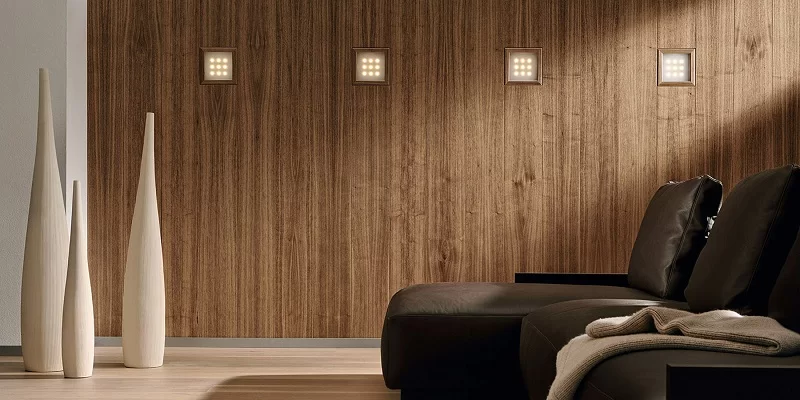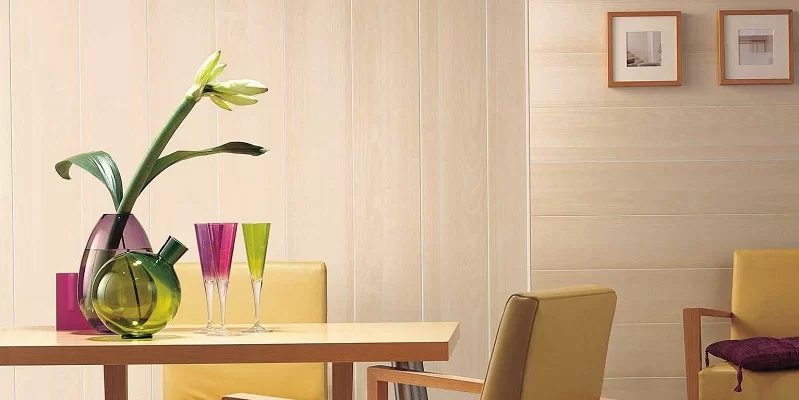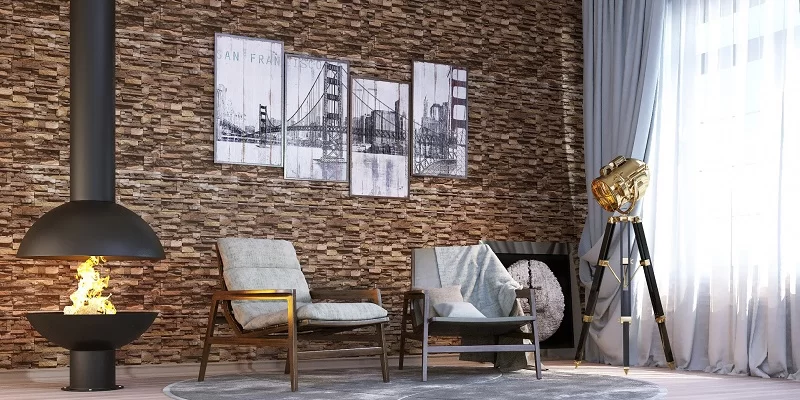The main problem of modern furniture is its price. Interior items made from natural materials that are environmentally friendly and safe are too expensive. And after buying an apartment, there is often simply no money left for solid wood furniture.
Therefore, it is necessary to choose less expensive materials. And in the lower price segment, options such as MDF and PVC are leading. These are plates made of wood chips or polyvinyl chloride, which are distinguished by their low price, visual appeal and good — for their cost — price characteristics. But which of the two materials should be preferred?
In this material, we will figure out what is the difference between MDF and PVC — and which is better.
MDF (medium density fibreboard)

MDF (medium density fiberboard) is a fairly modern material from which both furniture and decoration and interior items are made. For example, laminate, interior doors and partitions are made from it, as well as tables, facades of cabinets, bedside tables and much more.
MDF is made from wood shavings. It is pressed under high pressure into slabs, which are then covered with either a laminating film or veneer panels. There are two different technologies for the production of MDF:
-
Chips are pressed without the use of binders, but with additional heating. As a result, resin is released from the tree, which provides a tight connection. Such MDF boards are as environmentally friendly and safe as possible, but at the same time they are not very reliable, since there are very few binders;
-
Carbamide resin with a melamine modifier is added to the chips. This significantly increases the strength of the plate, while maintaining the environmental friendliness of the material.
So, regardless of the production technology, MDF boards have an E1 formaldehyde emission class — approximately the same as that of natural wood. Because of this, they are much safer than fiberboard or chipboard. They have a formaldehyde emission class — from E2 to E4, which makes them harmful to the respiratory system.
At the same time, MDF has extremely low mechanical strength. The material can crumble even from small impacts, distortions and loads. The second disadvantage is an unattractive appearance — MDF is not painted and has a uniform color of sawdust.
To solve these problems, MDF boards are further processed, which is most often carried out in two ways:
-
Lamination. A polymer or paper web is applied to the surface of the plate in one or more layers. It can be dyed, textured, or photo-coated;
-
Veneering. Veneer is applied to the surface of the plate — thin sheets of natural wood.
-
Multi-layer lamination is used, for example, in the production of laminate. In this flooring, MDF is just the base. Additionally, there are stabilizing, protective and decorative layers, which are made of polymeric materials. Also, this technology can be used in the production of interior doors, partitions and even furniture.
-
Veneering is used in situations where resistance to mechanical abrasion is not required. At the same time, the veneer increases the strength under impact and similar impacts, and also has some (not too significant) load-bearing properties. In general, veneered MDF boards are durable, reliable and durable, but they are more expensive than laminated ones.
In general, MDF is characterized as follows:
-
The basis is a slab of pressed sawdust;
-
The strength characteristics depend on the coating technology, but in general they leave much to be desired. Furniture and partitions made of MDF, even when veneered, last 5–7 years;
-
They are highly environmentally friendly. They practically do not emit harmful substances into the air, including formaldehyde — its emission is comparable to that of natural solid wood;
-
Well suited for use in children’s rooms, not too — in bathrooms and kitchens, as they are sensitive to moisture.
Like other wood-based materials, MDF can be further processed to improve performance. For example, it can be impregnated with special substances that provide fire resistance, water resistance and biostability. However, with comprehensive lamination of the plate, additional processing is not necessary.
It is worth noting that due to its structure MDF has excellent air and vapor permeability. This provides a comfortable microclimate in rooms fenced off from the rest by plates or doors made of this material.
And finally, MDF has a major advantage when used in apartment buildings. This material excellently “quenches” the sound — again, thanks to the porous structure. Its soundproofing properties are so good that high-quality acoustic cabinets are made of MDF.
So in rooms behind MDF doors and with laminate flooring it will be very quiet and calm. This is another plus for using these materials in nurseries and bedrooms.
Advantages
-
High environmental friendliness. Formaldehyde emission class — E1. Other harmful substances, in principle, are not emitted regardless of the production technology;
-
Low price. MDF is one of the cheapest structural and finishing materials;
-
Good air and vapor permeability, soundproofing properties.
Flaws
-
Low mechanical strength (however, for some products it is quite high due to lamination with polymers and epoxy resins);
-
The operational properties largely depend on the method of processing the material — lamination or veneering;
-
Extremely low resistance to water and moisture.
In general, modern MDF post-processing technologies make it possible to get rid of these shortcomings. For example, after laminating with acrylic or melamine resin, the material becomes resistant to moisture and water, and its strength becomes very high. So, it is this post-processing technology that is used in the production of class 34 laminate.
PVC (polyvinyl chloride boards)

PVC (polyvinyl chloride) is one of the varieties of plastics, which is widely used as a finishing and structural material. More precisely, for these purposes, not PVC itself is used, but multilayer boards based on it.
One of the most common forms of PVC production is three-dimensional panels with an internal cellular structure, the so-called PVC lining. They are used in decoration, both internal and external. Such a wide scope of use is due to three important advantages of the material:
-
Moisture resistance. The material is not damaged either by contact with high humidity air, as in bathrooms, or by direct wetness. Both the structure and appearance of the panels are preserved;
-
Easy to install and light weight. The placement of PVC panels does not require the use of any special equipment, or even the addition of load-bearing properties to the base due to the low mass of the finishing material;
-
Diverse design. The production technology of PVC panels allows you to give them absolutely any appearance — from imitation of wood texture or tiles to full-fledged photo printing.
At the same time, voluminous PVC panels (“lining”) have extremely low mechanical stability. They are easily damaged by any blows, covered with scratches and cut. They also do not have bearing properties. But they can bend while maintaining performance.
However, PVC has a very important drawback — this material is not at all resistant to heat. Already at +60 degrees, it begins to deform. But most importantly, when heated, PVC releases harmful and toxic substances that enter the air and have toxic properties.
As a result, PVC should not be used in children’s rooms and kitchens, placed in direct sunlight or near heaters or radiators. With caution, it is recommended to use this material for sheathing pipes with hot water — although, of course, its temperature is usually 60–75 degrees.
PVC is not resistant to low temperatures. In frost from ‑15 degrees and below, it becomes very brittle, easily breaks even with the weakest mechanical shocks. If internal stress was created in the PVC panels during the cladding of the facade — for example, when fixing with self-tapping screws — then when it gets cold, they can crack.
On the other hand, when used in the normal temperature range from ‑10 to +60 degrees, PVC panels are safe and comfortable.
In general, PVC is characterized as follows:
-
Base — plastic plate (vinyl chloride polymer, 57% chlorine, 43% ethylene);
-
In any case, the strength characteristics leave much to be desired, but due to the high wear resistance and ductility in the absence of mechanical shocks and similar damage, the panels can last forever;
-
They have low environmental friendliness. Safe only when used in a certain temperature range (up to +60 degrees) and in the absence of contact with direct sunlight or heating;
-
Well suited for use in bathrooms, as they are resistant to moisture; it is better not to place them in kitchens and nurseries because of the emission of harmful substances when heated.
The PVC used in the decoration also has an attractive appearance. Its texture can mimic the natural sheen of materials including lacquered wood, ceramic slabs or natural stone. However, PVC panels for facade decoration are usually simply painted with light-absorbing paints in a uniform tone and cannot boast of such visual appeal.
The disadvantages associated with low environmental friendliness appear only if the PVC is heated. At room temperature, this plastic is safe. In addition, it is odorless and does not irritate the skin.
Advantages
-
Low price. PVC panels are one of the cheapest finishing materials. The cost of a square meter of “lining” is from several of dollars. In addition, their placement will also not lead to additional costs, since they do not require preparation of the base and are distinguished by their low weight;
Resistant to water and moisture.
-
Designer variety. PVC panels can imitate the texture of wood, tiles, stone, be painted evenly, support photo printing and so on;
-
Easy to use. They do not need any super-reliable fastenings, they have a certain elasticity and resilience, they can be placed by gluing, screwing or in guides like siding;
Flaws
-
Low mechanical strength. Easily damaged by shock and piercing-cutting effects;
-
Low thermal strength. The recommended operating temperature range is from ‑10 to +60 degrees;
-
Low environmental friendliness. When heated, PVC begins to release harmful substances.
It should be noted that “pure” PVC is used in the decoration, design and manufacture of furniture is extremely rare. Usually, various additional substances are added to its composition, including plasticizers, softeners, heat stabilizers, softeners, and even lead. All of them additionally increase the danger of the material — but only when heated, when the PVC structure is drastically destroyed.
Which is better — MDF or PVC?

It should be noted that these materials are used for several different purposes. Structural solutions are usually made from MDF — partitions, doors, furniture facades. And from PVC — finishing materials: lining, plates and so on.
The difference is also manifested in the chemical composition. MDF is pure wood with the addition of bonding resins (or even without them at all), while PVC is plastic.
So let’s compare them!
|
|
|
|
|
The foundation
|
Pressed sawdust with or without resins
|
Plastic based on chlorine and ethylene
|
|
post-processing
|
Lamination (covering with a polymer film) or veneering (covering with thin sheets of solid wood)
|
Basically it goes without post-processing, but when creating panels that imitate materials or painted, it is laminated
|
|
Scope of use
|
Finishing or structural material (doors, partitions, lining, laminate, furniture)
|
Usually a finishing material, but sometimes used for the production of doors, partitions and furniture
|
|
Mechanical resistance (to shocks, cutting attempts, loads and distortions)
|
Low
|
Low to shocks, high to distortions and loads
|
|
Wear resistance (period of operation under normal conditions)
|
Low
|
high
|
|
Thermal stability
|
high
|
Low, collapses at temperatures below ‑15 degrees and above +60 degrees
|
|
Resistant to water and moisture
|
Low (fixed by resin lamination)
|
high
|
|
Resistant to direct sunlight
|
high
|
Low
|
|
Air and vapor permeability
|
high
|
Impenetrable
|
|
Soundproof properties
|
High
|
Low
|
|
Environmental friendliness and safety
|
High
|
Operation is allowed only in the temperature range up to +60 degrees
|
In general, it is better to play it safe and not use PVC for finishing kitchens and children’s rooms. And in other cases, it is recommended to build on the planned scope of use.

Добавить комментарий
Для отправки комментария вам необходимо авторизоваться.